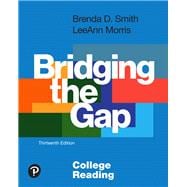For courses in Developmental Reading.
A comprehensive guide to reading, understanding, and retaining college-level material
Bridging the Gap: College Reading is trusted for its scaffolded approach to building upon prior knowledge, or schemata, and its unmatched quality and quantity of exercises. The higher-level text in the acclaimed Smith/Morris two-book series, it gives students ample opportunities to apply their skills, ultimately building new “bridges” with text-to-text, text-to-world, and text-to-self connections.
The 13th Edition upholds the philosophy and approach of previous editions, but in an updated and contemporary manner. The authors encourage students to build on their previous reading experience to develop strategies for the demands of college reading; each chapter is a stepping stone to the next. Readings have been updated throughout and include many engaging, relevant topics pertinent to the college community. Examples from respected sources such as The Associated Press and the Los Angeles Times model strong writing, and lexile levels have been added next to longer readings.
Also available with MyLab Reading
By combining trusted author content with digital tools and a flexible platform, MyLab Reading personalizes the learning experience and improves results for each student.
Note: You are purchasing a standalone product; MyLab Reading does not come packaged with this content. Students, if interested in purchasing this title with MyLab Reading, ask your instructor to confirm the correct package ISBN and Course ID. Instructors, contact your Pearson representative for more information.
If you would like to purchase both the text and MyLab Reading, search for:
0135300401 / 9780135300404 NEW MyLab Reading with Pearson eText -- Access Card -- for Bridging the Gap: College Reading, 13/e








